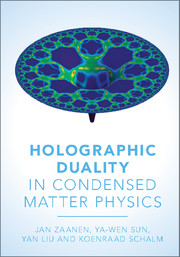Book contents
- Frontmatter
- Contents
- Preface
- 1 Introduction
- 2 Condensed matter: the charted territory
- 3 Condensed matter: the challenges
- 4 Large-N field theories for holography and condensed matter
- 5 The AdS/CFT correspondence as computational device: the dictionary
- 6 Finite-temperature magic: black holes and holographic thermodynamics
- 7 Holographic hydrodynamics
- 8 Finite density: the Reissner–Nordström black hole and strange metals
- 9 Holographic photoemission and the RN metal: the fermions as probes
- 10 Holographic superconductivity
- 11 Holographic Fermi liquids: the stable Fermi liquid and the electron star as holographic dual
- 12 Breaking translational invariance
- 13 AdS/CMT from the top down
- 14 Outlook: holography and quantum matter
- References
- Index
10 - Holographic superconductivity
Published online by Cambridge University Press: 05 November 2015
- Frontmatter
- Contents
- Preface
- 1 Introduction
- 2 Condensed matter: the charted territory
- 3 Condensed matter: the challenges
- 4 Large-N field theories for holography and condensed matter
- 5 The AdS/CFT correspondence as computational device: the dictionary
- 6 Finite-temperature magic: black holes and holographic thermodynamics
- 7 Holographic hydrodynamics
- 8 Finite density: the Reissner–Nordström black hole and strange metals
- 9 Holographic photoemission and the RN metal: the fermions as probes
- 10 Holographic superconductivity
- 11 Holographic Fermi liquids: the stable Fermi liquid and the electron star as holographic dual
- 12 Breaking translational invariance
- 13 AdS/CMT from the top down
- 14 Outlook: holography and quantum matter
- References
- Index
Summary
The AdS/CMT pursuit aimed at addressing the physics of finite-density quantum matter started seriously in 2008 with the discovery of holographic superconductivity, as first suggested by Gubser [347] and subsequently implemented in an explicit minimal bottom-up construction by Hartnoll, Herzog and Horowitz [348, 367]. This triggered a large research effort in the string-theory community. The underlying physics of spontaneous symmetry breaking means that this aspect of AdS/CMT is now quite well understood theoretically, much more so than, for instance, the fermion physics of chapters 9 and 11.
Holographic superconductivity is quite an achievement, however, since it is also far more than the straightforward physics of symmetry breaking. From the condensed matter perspective it should be viewed as the first truly mathematical theory for the mechanism of superconductivity that goes beyond the Bardeen–Cooper– Schrieffer (BCS) theory. As we emphasised in chapter 2, the Cooper mechanism, the central wheel of the BCS theory, critically depends on the normal state being a Fermi liquid. We continued by arguing in chapter 3 that the BCS vacuum structure does not need a Fermi-liquid “mother”. Starting from the RVB wave function Ansatz, we illuminated the case in which the BCS vacuum structure should be viewed in full generality as a long-range entangled state formed from a charge-2e Bose condensate living together with a Z2 spin liquid that is responsible for the “spinon” Bogoliubov excitations.
Holography takes this a step further by demonstrating that a generalisation of the Cooper mechanism is at work in the holographic strange metals which were the focus of the previous chapters. As in the Fermi-liquid case, the fermion pair/order parameter channel is singled out as the source of the instability. The phenomenology is very similar, up to the point that one can construct holographic Josephson junctions. One can contemplate s-wave superconductors but also p- and d-wave pairs and so forth. Crucially, a gap opens up at Tc showing a BCS (mean-field) temperature evolution, while at low temperature one might find long-lived Bogoliubov fermions. The differences from BCS are that this gap opens in the incoherent “unparticle” excitations of the strange metal – the sharp Bogoliubov particle poles develop only deep in the superconducting state. Also the rules determining the transition temperature drastically change: a “high” Tc becomes easy to accomplish.
- Type
- Chapter
- Information
- Holographic Duality in Condensed Matter Physics , pp. 328 - 376Publisher: Cambridge University PressPrint publication year: 2015



